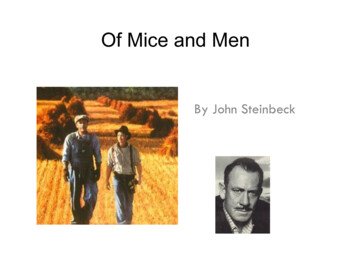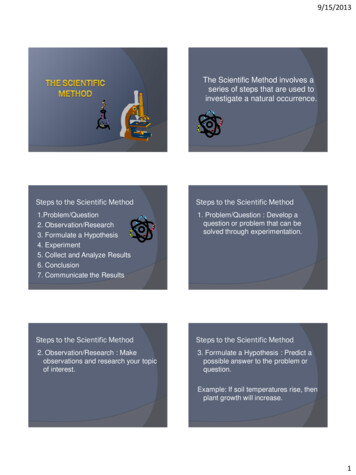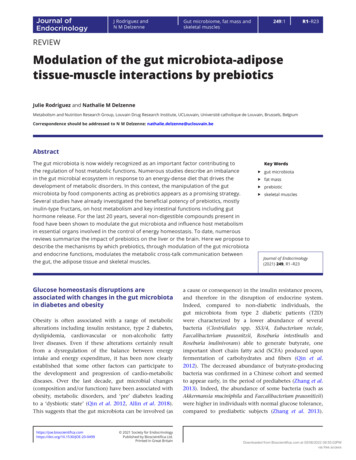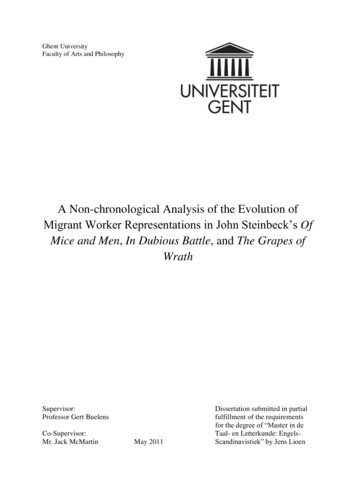
Transcription
Of Mice and MenBy John Steinbeck
John SteinbeckOne of The Great AmericanWriters of the 20th Century
A Look at the Author Born February 27th in 1902 in Salinas, California,John was the third of four children, and the only son. During his childhood, Steinbecklearned to appreciate his surroundings,and loved the Salinas countryside andthe nearby Pacific Ocean; it would bethis appreciation that would later comeout in his writing. Steinbeck worked during his summers as a hiredhand in nearby ranches.
The Fields of Salinas, California
TheBeautyofSalinas Rich,fer5lesoil
At the age of 14 he decided to be a writerand spent a lot of time writing in his room. In high school, Steinbeck did well in Englishand edited the school yearbook. From 1919-1925 Steinbeck attended StanfordUniversity to please his parents, but only chosecourses that interested him, classical and BritishLiterature, writing courses, and an odd sciencecourse. However, Steinbeck did not receive a degree because hewould drop in and out of school, sometimes to work withmigrant workers and bindlestiffs on California ranches.
What’s a Bindlestiff?A hobo, especially one who carries a bedroll.
John Steinbeck died on December 20, 1968, at hisapartment in New York City. His wife took him home to Salinas to be buried nearthe land that he spent his life writing about.
Mural overlooking The NationalSteinbeck Center in Salinas
The Book Of Mice and Men was originally called SomethingThat Happened. When Steinbeck first thought of the idea for the bookhe intended it to be for children. Steinbeck told a friendthat he was experimenting with a new “dramatic form.” In May 1936, he wrote a manuscript, but his puppy (asetter called Toby) ate it!
Of Mice and Men The novel deals withthe issues dear toSteinbeck’s heart poverty, homelessness,the exploitation ofitinerant workers, thefailure of the Dream,America’s generalmoral decline.
The setting in Of Mice and Men The novel is set in thefarmland of the Salinasvalley, where JohnSteinbeck was born. The ranch in the novel isnear Soledad, which issouth-east of Salinas onthe Salinas river. The countrysidedescribed at thebeginning of the novel,and the ranch itself isbased on Steinbeck’s ownexperiences.
Soledad, California
California in the 1930s
Why Migrant Workers? Before technology createdfarm machinery, humanshad to do a lot of the farmwork by hand. Between the 1880s andthe 1930s, thousands ofmen would travel thecountryside in search ofwork. Such work included theharvesting of wheat andbarley.
Migrant Workers These workers would earn 2.50or 3.00 a day, plus food andshelter. During the 1930s, theunemployment rate was high inthe U.S., and with so many mensearching for work, agencieswere set up to send farmworkers to where they wereneeded. In the novel, George and Lennie(the two main characters) weregiven work cards from one ofthe farm work agencies.
The American Dream You can be successful if youwork hard and live morally. America is the land ofopportunity. Freedom to work hard and behappy is enshrined in theConstitution. The Dream assumes equality ofopportunity, no discrimination,freedom to follow goals andfreedom from victimization.
Dreams George and Lennie have a dream,even before they arrive at theirnew job on the ranch, to makeenough money to live "off the fatof the land" and be their ownbosses. Lennie will be permitted,then, to tend the rabbits.
Dreams When George goes into a full description ofthe dream farm, its Eden-like qualitiesbecome even more apparent. All the foodthey want will be right there, with minimaleffort. As Lennie says:– "We could live offa the fatta the lan'." When George talks about their farm, hetwice describes it in terms of things heloved in childhood:– "I could build a smoke house like the onegran'pa had."George yearns for his future to reflect thebeauty of his childhood.– "An' we'd keep a few pigeons to go flyin'around the win'mill like they done when Iwas a kid."
Main Characters: Lennie &George
Lennie Small Lennie is a large, lumbering,childlike migrant worker. Due tohis mental disability, Lenniecompletely depends upon George,his friend and travelingcompanion, for guidance andprotection. Gentle and kind, Lennie does notunderstand his own strength. Hislove of petting soft things, such assmall animals, dresses, andpeople’s hair, leads to disaster.
George Milton George is a small, wiry, quickwitted man who travels with,and cares for, Lennie. Althoughhe frequently speaks of howmuch better his life would bewithout his caretakingresponsibilities, George isobviously devoted to Lennie.
Candy Candy is an aging ranch worker.He lost his hand in an accidentand worries about his future onthe ranch. Fearing that his age ismaking him useless, he seizes onGeorge’s description of the farmhe and Lennie will have, offeringhis life’s savings if he can joinGeorge and Lennie in owning theland.
Curley Curley is the boss’s son.Curley wears stacked-heeledboots to distinguish himselffrom the field hands. He is aconfrontational, mean-spirited,and aggressive young manwho seeks to compensate forhis small stature by pickingfights with larger men.Recently married, Curley isplagued with jealoussuspicions and is extremelypossessive of his flirtatiousyoung wife.
Curley’s Wife Curley’s wife is the only femalecharacter in the novel, Curley’swife is never given a name and isonly referred to in reference to herhusband. Like the ranch-hands,she is desperately lonely and hasbroken dreams of a better life.
Crooks Crooks, the black stable-hand, gets his name from his crooked back.Proud, bitter, and funny, he is isolated from the other men because ofthe color of his skin. Despite himself, Crooks becomes fond of Lennie.
Slim A highly skilled mule driver and the acknowledged “prince” of the ranch,Slim is the only character who seems to be at peace with himself. Theother characters often look to Slim for advice.
Other Characters Carlson - A ranch-hand The Boss - The stocky, well-dressed man in charge of the ranch,and Curley’s father. He is never named and appears only once, butseems to be a fair-minded man. Aunt Clara - Lennie’s aunt, who cared for him until her death, doesnot actually appear in the novel except in the end as a vision.
Themes in Of Mice and Men The Nature of Dreams– In essence, Of Mice and Men is as much a story about thenature of human dreams and aspirations and the forces thatwork against them as it is the story of two men.– Humans give meaning to their lives—and to their futures—by creating dreams. Without dreams and goals, life is anendless stream of days that have little connection ormeaning.– George and Lennie’s dream—to own a little farm of theirown—is so central to Of Mice and Men that it appears insome form in five of the six chapters. Loneliness– In addition to dreams, humans crave contact with others togive life meaning. Loneliness is present throughout thisnovel.
Themes in Of Mice and Men Powerlessness– Steinbeck’s characters are often the underdogs, and he showscompassion toward them throughout the body of his writings.Powerlessness takes many forms—intellectual, financial, societal—andSteinbeck touches on them all. Fate– Life’s unpredictable nature is another subject that defines the humancondition. Just when it appears that George and Lennie will get theirfarm, fate steps in. My Brother’s Keeper– Steinbeck makes the reader wonder whether mankind should go alonein the world or be responsible and helpful to others who are lessfortunate. Nature– Steinbeck uses nature images to reinforce his themes and to set themood.
Of Mice and Men – Title’s Origin The title of the novel comes from a poemby the Scottish poet Robert Burns (1759-96)The best laid schemes o’ mice and menGang aft agley [often go wrong]And leave us nought but grief and painFor promised joy!The best laid schemes of mice and menoften go wrong- referring to a little mousewho had so carefully built her burrow in afield to protect herself and her little micebabies – and the burrow is turned overand destroyed by the man plowing.
This powerpoint was kindly donated g.com is home to over athousand powerpoints submitted by teachers. This is acompletely free site and requires no registration. Pleasevisit and I hope it will help in your teaching.
The Book Of Mice and Men was originally called Something That Happened. When Steinbeck first thought of the idea for the book he intended it to be for children. Steinbeck told a friend that he was experimenting with a new “dramatic form.” In May 1936, he wrote a manuscript, but his puppy (a setter called Toby) ate it!










